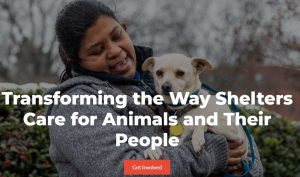Module 6: Integration of shelter and community healthcare programs for at-risk pets
Human Animal Support Services
The national shut-down response to the COVID pandemic in 2020 caused shelters to abruptly pivot to providing essential admission services only, evacuating thousands of shelter pets into foster or adoptive homes, reducing both the number of pets in the shelter and staff to care for them to the lowest levels in decades, and offering veterinary care via curbside appointments or telemedicine.
In the process, shelters discovered that communities were eager to help keep animals out of the shelters via a variety of innovative approaches necessitated by the pandemic. Even before the pandemic, many community-service programs were actively supporting access to veterinary care and keeping pets with their families and out of shelters before the pandemic. You learned about a few of these programs and their value in preserving the human-animal bond (Pets for Life, CARE, Community Veterinary Outreach, My Dog Is My Home, PALS).
The overwhelming community response to emptying the shelters during the pandemic, coupled with emergence of community service programs for at-risk pets, has opened the door to an entirely different vision for animal sheltering–one that prioritizes caring for animals in homes instead of institutions. The mission of shelters is long overdue for a new approach that is in line with human social services and social justice movements and considers animals as part of family systems.
Human Animal Support Services (HASS) is a complete re-visioning of how animal shelters operate. The primary goal of HASS is to keep people and pets together through innovative social service programs and strategies where shelters collaborate with their community to assist the majority of pets without separating them from their owners. HASS is a national coalition of animal welfare and shelter leaders developing transforming policies and toolkits piloted by more than 30 shelters in the US and Canada. The pilot shelters range from small rural animal services with fewer than 10 staff members to some of the largest metropolitan shelters with more than 100 staff. The pilot shelters road-test the new programs to determine which can be replicated in communities everywhere.
Watch This
The New Model of Animal Services Explained (4:00).
The HASS vision is that animal shelters will serve as an emergency room and crisis response center. Shelters will house animals needing urgent medical care, animals in immediate danger due to cruelty or neglect, animals with no other housing options, animals that pose a danger to the community, provide temporary boarding for pets with owners facing a crisis, and provide space for pets impacted by disasters. The shelter also serves as a community resource center for outreach programs keeping pets in homes. Shelter personnel will use a case management approach to assess the needs of individual animals and pet owners and match the needs with the appropriate veterinary or human social service programs.
The 12 Elements of the HASS Model for Animal Shelters
These elements represent the programs that the pilot shelters are currently testing
- Have a comprehensive lost pet reunification service to successfully get most roaming pets home without them entering the shelter system.
- Provide pet owners with access to pet support services to keep the family together, including housing, medical and behavioral support, and food and supplies.
- Provide tools and shelter staff support to pet owners so they can re-home pets they can no longer keep.
- Citizens can reach the shelter quickly and easily using remote technologies like text, phone and web chats.
- The core functions of the shelter are to provide emergency medical care and short-term housing for pets with urgent needs and to ensure public safety and public health priorities are met.
- Starting at intake, identify outcome pathways for pets that must enter the shelter to shorten their in-shelter stay.
- The majority of pets who enter the shelter system are placed in foster homes within hours or days of arrival and foster pets are adopted directly from their foster homes.
- Animal shelter staff serve as trained case managers, helping people keep their pets; providing resources and support to struggling pet owners; and assisting owners who need to rehome their pets, and helping people find missing or lost pets.
- Telehealth services are available for pet owners considering surrender, for foster caregivers, and for finders of pets who may be sick or injured.
- Human social services agencies, veterinary practices, rescue groups and other community partners work closely with the animal services organization, treating people and animals as a family unit.
- Animal control and field services protect public health and safety, enforce animal cruelty and neglect laws, and address the root causes of animal problems. They provide support, education, and access to care to the community.
- Volunteers are engaged in every area of shelter operations and play a key role in implementation of HASS programs.
The 7 HASS Values
- Community-centered: Animal welfare solutions are rooted in the values and needs of each community.
- Connection: We emphasize the interconnections of people, animals and the environment.
- Cultural humility: We demonstrate an ongoing commitment to self-evaluation and self-critique, to addressing power imbalances and to developing mutually beneficial partnerships with communities we serve.
- Justice and Equity: We consistently work to combat discrimination and inequity in animal services and to build programs and services that are accessible and welcoming to all.
- Lifesaving: We believe every animal who enters a shelter should receive urgent, individualized treatment and care, with the goal of a live outcome.
- Relationships: We proactively work to build strong and lasting human-animal relationships in our communities and affirm our central role of protecting the bonds between people and animals.
- Support: We ensure people working in animal services organizations have access to support, resources, and information to promote their physical and emotional well-being.
Check out the HASS website to learn more about the programs and the pilot shelters.


